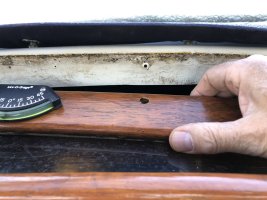It depends on how much you want to do now and how much you want to do later. Also, if you cover your boat or if it is in the sun. If you want it to last in the sun you need to take it down to wood with hand sanding (this is the way Hinckley does it) and lay down a couple diluted 50/50 varnish coats to soak into the wood. Otherwise moisture will soon turn things black or dark from the inside out over time. If you want it to last and if it is in the sun, you would put down 5 or 6 coats and sand very lightly between coats. Tape off the wood so you do not get it on the rest of the boat--varnish is a bitch to remove when it dries. Then you have a base that will last a few years. You can quickly do a coat in the Spring each year after that and it should keep up for several years. You are going to get a lot of different views on this. Most folks are looking for a short cut or magic product. I find the real stuff is not that difficult to use if you are willing to learn. And not much more work than the magic stuff in my experience. The charter boats in the Caribbean swear by Epifanes products because they have very good UV filters though the stuff is expensive.
Varnishing is an art, but once you get it down and get the materials together with a little experience, it does not take long to do and it looks great. You need good quality sandpaper finishing with 220 or 320 on a foam block, tack cloths, a good bristle brush or quality foam brush. You need to vacuum and get the dust out with quality tack cloths before you put the varnish on if you want it to look nice. Or you can just slap some varnish or stuff that looks like varnish if you are not too fussy. There is a lot of latitude depending on your willingness to accept the outcome. Most boats I see are poorly done, but if the folks like them, who cares?




